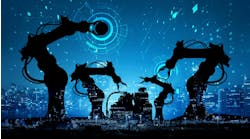By Adi Pendyala, senior director at AspenTech
Historically, one of the biggest challenges in the industrial world is navigating its volatile nature, like supply-and-demand swings, fluctuating pricing and evolving trade opportunities. It takes an agile industrial organization, one that can quickly adapt to new realities and continuously uncover new opportunities, to meet the challenge effectively.
While efficiency and agility will always be central to succeeding in the unpredictable industrial landscape, a second, more “modern” challenge is now rearing its head, and every capital-intensive industry needs to look it in the eye: sustainability.
Industrial organizations have come under an increasing amount of scrutiny to follow a more proactive strategy to address environmental goals. Tackling productivity, efficiency and sustainability at the same time is often a contentious balancing act.
However, advancements in artificial intelligence make it possible.
What is industrial AI?
AI finally has real-world impact and meaning in the industrial landscape because it can steer any company toward a greener and more efficient future, while lowering the bar for the expertise typically needed for modeling process systems that support greener operations.
What do we mean by industrial AI? AI is not a stand-alone technology, at least in the way it applies to the industrial world—it is a collection of different technologies to enable a system to make it more intelligent. Industrial AI requires a combination of domain expertise, first-principles of engineering, software, AI and data science – it can then deploy machine-learning algorithms as fit-for-purpose, domain-specific industrial applications.
These elements on their own are not enough to lead to the best-informed decisions. It requires a combination of these elements and a holistic approach to achieve success.
Here’s an example of how this might work in a real-world context: if an industrial organization wanted to curb emissions associated with a specific process, industrial AI could enable the process engineers in that organization to more comprehensively model that complex simulation in different ways and with greater accuracy and speed than would be possible to do manually or by relying on first principles of engineering, alone. This would enable the organization to be more successful, not only curbing emissions for that process but also sustaining the outcomes longer, without needing many dedicated data-science experts to analyze complex AI and machine-learning methods.
With the skills gap reality that exists in the industrial world and a rapidly retiring expert workforce, enabling AI to make decisions based on the analysis of real-time industrial data (rather than hard coding) and the real-world guardrails that domain-expertise context provides opens the door to so many possibilities when it comes to different industrial applications and solving for specific business pain points.
When applying industrial AI to sustainability business goals, there are three key areas in which it has real-world impact: reduction of energy waste, improvement of emissions tracking and the scale-up of carbon-capture technology. Let’s explore…
Reducing energy waste
AI-enabled predictive analytics and modeling are key to reducing energy waste and lowering resource consumption. Predictive analytics in maintenance, the largest use case for industrial AI, relies on AI-powered digital agents to detect failure patterns in assets and equipment, and can give organizations weeks, if not months, of advance warning of looming malfunctions or failures, giving them the time to address them strategically and avoid unplanned downtime.
This industrial AI use case provides more accurate anomaly-detection and failure-pattern recognition, as while the system learns during the process through semi-supervised learning. This gives the AI the ability to understand if an anomaly will lead to failure or not. The data points and failure patterns are so complex and require such a deep analysis of the data that it would be nearly impossible for the analysis to be done manually.
From an efficiency perspective, unplanned downtime is a resource and financial drain. However, it is also an energy drain. Over time, malfunctioning equipment and assets that go undetected and lead to failure use up more energy during production, much like how a weak heart has to work harder to circulate blood throughout the body. Any energy used to power processes that eventually require shutdown due to asset failure is energy wasted and lost forever.
Additionally, sometimes equipment failure can lead to catastrophic events that issue noxious gases into the environment at an alarming rate and in large quantities. AI-driven predictive analytics can help companies avoid these environmentally harmful events from occurring.
Curbing emissions with better calculations
The other benefit of both AI-powered predictive analytics and modeling is the ability to curb emissions and perform more accurate industrial-emissions calculations. Intelligent algorithms can improve the accuracy of calculated greenhouse-gas emissions as well as offer sustainability-related risk assessments of company locations. Risk assessments provide comparison of sustainability-goal variance across sites within the same company, ultimately giving industrial executives a deeper understanding, at the plant level, across the key decision criteria.
For example, an industrial organization can employ diverse applications of industrial AI to optimize across multiple dimensions such as energy consumption and production-capacity analysis, while significantly improving the accuracy of calculating emissions associated within these complex processes. As a result of comprehensive plant-digitization initiatives, these organizations can create an online digital twin of their operations and capture the various elements of data—across the industrial asset lifecycle—to support complex, multivariate decisions.
Furthermore, these industrial AI models are reinforced through analysis of empirical data from actual plant operations, enabling a more comprehensive representation of the plant, keeping the models more relevant over longer periods.
Scaling up carbon-capture technology
For industrial plants looking to improve environmental performance within operations, carbon-capture technology that blocks CO2 from escaping into the environment is an excellent option, and one which relies heavily on artificial intelligence for both its design and validation. The use of AI and domain expertise in the context of asset and plant design and operating-plan validation is essential to understanding how to better optimize for carbon-capture goals. Embedded AI-modeling applications to scale up proprietary carbon-capture systems can yield a diverse range of scenarios for achieving it as well, better accounting for the entire industrial-asset lifecycle and decarbonizing across the value chain.
Artificial intelligence can support many different sustainability initiatives. It offers a pathway to creating a greener industrial world, all without requiring additional expertise, something many organizations currently lack and see as a barrier to ramping up AI capabilities. It enables organizations to balance profitability with sustainability, ultimately setting them up for more success in both the present and future.
The calls for green initiatives will only grow in strength, so industrial organizations need to be prepared to meet those calls with solutions that help them reach advanced sustainability targets faster and more effectively, without relying on expertise that might not be available to them.


